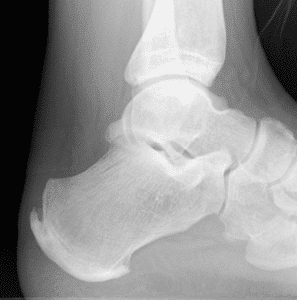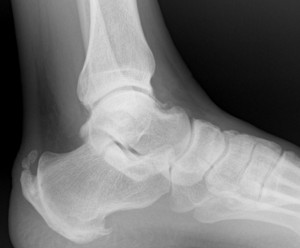Haglund’s Deformity Treatment
Explained by a Haglund’s Deformity Specialist in Orange County.
A bony enlargement on the back of the heel that most often leads to painful bursitis.
In Haglund’s deformity, the soft tissue near the Achilles tendon insertion becomes irritated and calcified when the bony enlargement rubs against shoes.
Often called Pump Bump because the rigid backs of pump-style shoes can create pressure that aggravates the enlargement when walking.
Symptoms of Haglund’s Deformity Pain
Haglund’s deformity can occur in one or both feet. The signs and symptoms include:
A noticeable bump on the back of heel bone.
Pain in the area where the Achilles tendon inserts into the heel.
Edema in the back of the heel.
Erythema near the irritated tissue.
Pain in the calf muscle.
Causes of Haglund’s Deformity
Patients can inherit a type of foot structure that makes them prone to developing this condition.
High arches can contribute to Haglund’s deformity.
It is the inflamed bursa that produces the redness and swelling associated with Haglund’s deformity.
A tight Achilles tendon plays a role in Haglund’s deformity.
Diagnosis of a Haglund’s Deformity
X-rays can be ordered to help evaluate the structure of the heel bone.
Treatment of a Haglund’s Deformity
Non-surgical Approaches to a Haglund’s Deformity
Non-surgical treatment of Haglund’s deformity is aimed at reducing the inflammation of the bursa by decreasing the pull of the achilles tendon.
While these approaches can resolve the bursitis, they will not shrink the bony protrusion.
Heel lifts are a great way to decrease pain.
A night splint is an easy way to stretch the calf muscle. Be sure your leg is straight.
Stretching out the calf muscle is very important.
Surgical treatment of a Haglund’s Deformity
Performed when conservative treatment has failed.
I usually do not need to shave off the bump or even detach the achilles tendon. The surgery release is done in the calf mucle. By giving the achilles more length at the calf, pain is significantly decreased. It is called a Strayer Procedure.
By doing the surgery higher up there is a much faster recovery. This procedure also gets rid of the chance of scar tissue at the distal achilles.
Patients walk right after the surgery and resume running in about 1 month.
If the bump causes the pain, removing the bony overgrowth and the degenerative parts of the achilles tendon if that is the main reason of the pain.
Contact Dr. Kolodenker for more questions on Surgery of a Haglund’s Deformity.
Office is located in Irvine, CA – Orange County
Disclaimer
These videos are for information only. The contents of the videos, such as graphics, images, text, quoted information and all other materials (“Content”) are provided for reference only, do not claim to be complete or exhaustive or to be applicable to any particular individual’s medical condition. Viewers should always consult with a qualified and licensed physician or other medical care provider. Users are warned to follow the advice of their physicians without delay regardless of anything seen or read in these videos. OC Podiatry assumes no duty to correct or update the Content nor to resolve or clarify any inconsistent information that may be a part of the Content. Reliance on any Content is solely at the User’s risk. The videos may contain health or medically related materials considered sexually explicit. Users are warned that if they may be offended by such Content, an alternate source of information should be found. Publication of information or reference in videos to specific sources such as specific products, procedures, physicians, treatments, or diagnoses are for information only and are not endorsements.
Last Updated 1-03-2017




